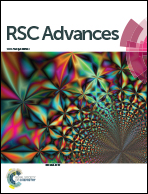Heterogeneous Cu(ii)/l-His@Fe3O4 nanocatalyst: a novel, efficient and magnetically-recoverable catalyst for organic transformations in green solvents†
Abstract
A novel, efficient and green Cu(II)/L-His@Fe3O4 catalyst has been applied successfully in the synthesis of heterocyclic compounds. The resulting catalyst was used in the synthesis of 2,3-dihydroquinazolin-4(1H)-ones, polyhydroquinolines and 2-amino-6-(arylthio)pyridine-3,5-dicarbonitriles as biologically interesting compounds. The present research is focused on investigation of recycling, reusability and stability of the catalyst in phase reactions. The Cu(II)/L-His@Fe3O4 catalyst was used at least six times with comparable activities to that of fresh catalyst. The chemical composition and the structure of the catalyst were analysed by TGA/DTG, EDS, XRD, VSM, FT-IR and SEM.



 Please wait while we load your content...
Please wait while we load your content...